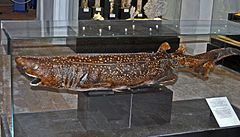Echinorhinus
This is an old revision of this page, as edited by 66.61.83.123 (talk) at 01:21, 31 December 2015. The present address (URL) is a permanent link to this revision, which may differ significantly from the current revision.
| Echinorhinus | |
|---|---|

| |
| Bramble shark, Echinorhinus brucus | |

| |
| Echinorhinus brucus, mounted specimen, on display at the Museo storia naturale di Pisa | |
| Scientific classification | |
| Kingdom: | |
| Phylum: | |
| Class: | |
| Subclass: | |
| Superorder: | |
| Order: | |
| Family: | Echinorhinidae T. N. Gill, 1862
|
| Genus: | Echinorhinus Blainville, 1816
|

| |
| The distribution of the two Echinorhinus species | |
Echinorhinus is the only extant genus in the family Echinorhinidae.
Taxonomy
While some scientists have proposed that the Echinorhinidae be given an order separate from Squaliformes, the general current consensus is that the Echinorhinidae are still a family in the order Squaliformes.[2]
Etymology
The name is from Greek echinos meaning "spiny" and rhinos meaning "nose".
Species
- Echinorhinus brucus Bonnaterre, 1788 (bramble shark)
- Echinorhinus cookei Pietschmann, 1928 (prickly shark)
Description
This genus includes two extant species of uncommon, little-known sharks. Both species are relatively large sharks, at 3.1 to 4.0 m (10.2 to 13.1 ft) in body length. They are characterized by a short nose and by rough, thorn-like dermal denticles scattered over its body, some of which may be fused together. They have no anal fin. Two small spineless dorsal fins are positioned far back.
Biology
They are ovoviviparous, with the mother retaining the egg-cases inside her body until they hatch, producing litters up to 24 pups.[3] They feed on smaller sharks, smaller bony fish, and on crabs and cephalopods.
Distribution
These sharks are found worldwide in cold temperate to tropical seas from the surface down to 900 m (3,000 ft).[3]
See also
References
- ^ Sepkoski, Jack (2002). "A compendium of fossil marine animal genera (Chondrichthyes entry)". Bulletins of American Paleontology. 364: 560. Retrieved 2008-01-09.
{{cite journal}}: Cite has empty unknown parameter:|coauthors=(help) - ^ Compagno, 2005. "Sharks of the World". ISBN 9780691120720
- ^ a b Froese, Rainer; Pauly, Daniel (eds.). "Family Echinorhinidae". FishBase. January 2009 version.
- "Echinorhinus". Integrated Taxonomic Information System. Retrieved 4 May 2006.
- Froese, Rainer; Pauly, Daniel (eds.). "Family Echinorhinidae". FishBase. January 2006 version.
- Froese, Rainer; Pauly, Daniel (eds.). "Species in genus Echinorhinus". FishBase. January 2006 version.
- FAO Species Catalogue Volume 4 Parts 1 and 2 Sharks of the World
